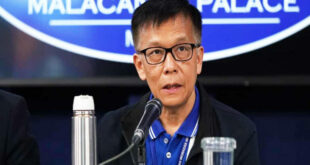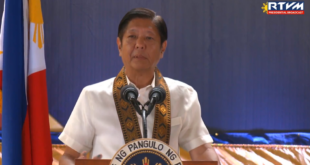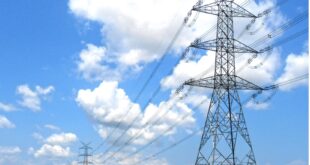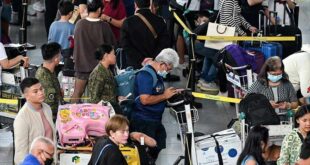
Finance Secretary Benjamin Diokno on Thursday encouraged the Singapore-based business community to invest in the Philippines, including the upcoming Maharlika Investment Fund, and take part in the country’s high-growth momentum.
Diokno said during the Philippine Economic Briefing (PEB) in Singapore the opening up of some sectors for 100-percent foreign ownership could be an incentive for investors to invest in the Philippines.
“The private sector is welcome to invest in 194 infrastructure projects. If you want to come in, you can invest in those projects. You can also invest in the Maharlika Investment Fund,” Diokno said.
Diokno said learning from some of the strongest economies in the world, including Singapore, the Philippines is now training its eyes on longer-term investments for the Filipino people.
“Just two weeks ago, the Philippine Congress approved the Maharlika Investment Fund bill creating the country’s first sovereign wealth fund. The Maharlika Investment Fund is designed to advance the Philippines’ long-term development goals through the effective inter-generational management of our government financial assets. This will be an important addition to our existing funding mechanisms, with the aim of promoting socio-economic development through investments in strategic, high-return, high-impact sectors, including infrastructure,” he said.
“We look forward to its enactment in the coming weeks and we are eager to explore co-financing opportunities with foreign investors, multilateral institutions and other sovereign wealth funds around the world,” Diokno said.
President Marcos has yet to sign the bill into law, which will also need its implementing rules and regulations.
Other members of the economic team that attended the briefing were Budget Secretary Amenah Pangandaman and National Economic and Development Authority Secretary Arsenio Balisacan.
“We invite you to become our partners… Now is the time to invest in the Philippines,” Pangandaman said in the panel discussion right after the economic briefing.
The economic team cited the compelling factors why foreign investors should consider the Philippines as an ideal investment destination.
They mentioned the structural reforms implemented in previous and present administrations, strong macroeconomic fundamentals that remained solid even during the pandemic, the strong external position, a stable banking system, an easing inflation rate, sustained remittances from overseas Filipino workers that is one of the drivers of robust consumer spending, improving labor markets, and the young and talented Filipino workforce that could be the pillars of economic growth in the years to come.
Balisacan said the Philippine economy could even surpass its growth potential of around 6 percent annually. Just last year, gross domestic product (GDP) grew by a 46-year high of 7.6 percent, over the target range of 6.5 to 7.5 percent.
Bangko Sentral ng Pilipinas Dputy Governor Francisco Dakila Jr. said the financial sector is one area that might interest foreign investors, especially after the liberalization of the banking industry a few years ago.
“At the start of the pandemic, there was a survey about the outlook on non-performing loans [in the Philippines]. Those surveyed saw it rising to about 8 percent due to the pandemic but that did not happen. NPL now is at 3.5 percent… Banks are very well capitalized and because of this, the Philippine financial sector is very attractive [to investors],” Dakila said.
The economic managers, however, acknowledged the persistent presence of risks that could stifle the further growth of the economy. These include elevated inflation, the El Nino phenomenon, slower global growth, as well as geopolitical tensions, especially the continuous war between Russia and Ukraine that has been affecting prices of global commodities.
This year, the government projected a 6 to 7 percent growth in GDP, anchored on robust and strong domestic demand.
Meanwhile, NEDA assured investors that the Philippine government would continue to prioritize infrastructure development, while also maximizing the benefits of a large consumer base and demographic dividend.
Balisacan underscored the importance of funding and investing in the 194 “Build-Better-More” infrastructure flagship projects of the Marcos administration. He further encouraged businessmen to become invaluable partners in achieving development goals.
“The private sector is the Philippines’ engine of growth and innovation, and tapping into its financial muscle, as well as technical and managerial capacities will ultimately result in better public services, lower consumer prices, and improved quality of life for all Filipinos,” said Balisacan,
The nation’s chief economist also said President Ferdinand R. Marcos Jr. recognizes the immense potential of engaging the private sector. Thus, he has instructed the economic managers to pursue public-private partnerships (PPPs) as a means of financing the development of critical infrastructure in the country.
“The President has given the directive to promote PPPs as a mode of financing these IFPs and other high-impact projects in physical, digital, and social infrastructure. These include investments for transport and road projects, property development, health, water and sanitation, ICT, solid waste management, energy, and tourism,” Balisacan said.
Furthermore, the Marcos administration has committed to sustaining annual spending on infrastructure at around 5 to 6 percent of GDP from 2023 to 2028. This is equivalent to approximately $20 billion to $40 billion per year. Many of these projects will focus on fundamental infrastructure that serves as a growth driver, enabling economic opportunities and job generation.
During the fourth meeting of the NEDA Board, the government approved 194 IFPs worth about $148 billion or P8.3 trillion. Most of these projects focus on enhancing physical and digital connectivity, as well as managing water resources. More than half of the projects will be funded through official development assistance (ODA), while 30 percent will be financed through PPPs.
Balisacan said these projects will enable the government to achieve its goal of addressing both short-term challenges and long-term constraints to job creation and poverty reduction. These projects are aligned with the Philippine Development Plan 2023-2028, which underscored the importance of infrastructure in addressing the obstacles to business investment and the creation of high-quality jobs.
The NEDA chief encouraged the business sector to finance these projects by highlighting the advantages of investing in the Philippines, which has a vast consumer base of 110 million people.
Balisacan also noted that the country has been included in the Regional Comprehensive Economic Partnership, which is the world’s largest free trade agreement. This agreement enables businesses access to more sources of inputs, thereby promoting economic growth.
“The country is more open to business now than ever before, and we look forward to working with you to create a more prosperous, inclusive, and resilient Philippines,” he said.
The PEB in Singapore was jointly organized by the BSP’s Investor Relations Group (BSP-IRG), Department of Finance (DOF), DBS Bank, and the Investment & Capital Corporation of the Philippines (ICCP).
It was attended by around 110 foreign investors from business and financial communities, including business chambers and the media.
“Beyond question, Singapore holds a special place in the Philippines’ growth story. This year, we celebrate 54 years of diplomatic relations, an enduring partnership characterized by strong political, economic, cultural, and people-to-people ties,” Diokno said. (See full story online at manilastandard.net)
Singapore is the Philippines’ top source of foreign direct investment inflows, with investments in key sectors including renewable energy, infrastructure, healthcare, manufacturing, and information and communications technology. It is also the Philippines’ seventh largest trading partner globally, fifth largest export market, and sixth largest import supplier.
The economic team held its first economic briefing in Singapore on Sept. 9, 2022. Since then, the Philippine economy has witnessed positive developments, growing by a robust 7.6 percent in 2022 and 6.4 percent in the first quarter of 2023, outpacing emerging Asian economies including India, Malaysia, Indonesia, China, Vietnam, and Thailand.
The expansion was broad-based across the three major production sectors, led by services (8.4 percent), then industry (3.9 percent) and agriculture (2.2 percent). — Julito G. Rada
*****
Credit belongs to : www.manilastandard.net
 Atin Ito First Filipino Community Newspaper in Ontario
Atin Ito First Filipino Community Newspaper in Ontario






